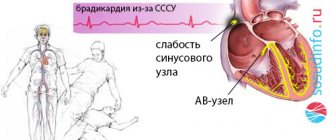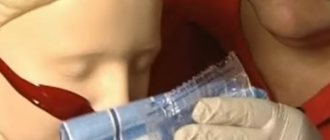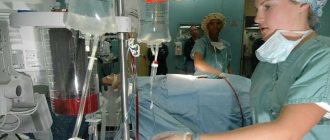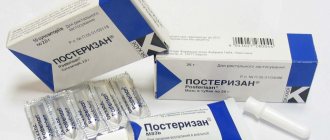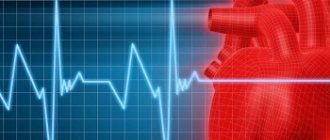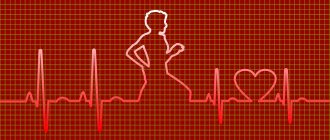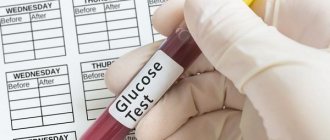Hypoglycemia is a decrease in the concentration of glucose in the blood plasma in full-term newborns to less than 2.7 mmol/l, in older children - less than 2.2 mmol/l. The causes of hypoglycemia in diabetes mellitus are insufficient food intake, heavy physical activity, and overdose of sugar-lowering drugs. The main non-diabetic causes of hypoglycemic conditions in children are: starvation, diseases accompanied by malabsorption syndrome, hormonal regulation disorders (adrenocortical insufficiency, hypothyroidism), chronic renal failure, poisoning (ethanol, salicylates, β-blockers).
Features of resuscitation
Resuscitation must be started in adults and children, without waiting for the arrival of ambulance specialists, when symptoms appear: lack of pulse in the carotid arteries, lack of breathing, the skin acquires a gray-bluish tint, the pupils are dilated and do not respond to light.
- Place the patient on the floor or other hard, flat surface.
- Tear or cut outer clothing to provide access to the chest.
- Tilt the patient's head back as far as possible, place one hand on the forehead, and with the other push the patient's lower jaw forward. This technique ensures airway patency.
- Make sure there are no foreign bodies in the mouth and throat, and if necessary, remove mucus with a quick movement.
Compliance with the rules of resuscitation is a step towards its successful completion.
Breathing “mouth to mouth”. A napkin, a piece of gauze or a handkerchief is placed on the patient’s lips. A deep breath is taken, the lips are pressed tightly to the patient’s mouth. Then they exhale forcefully (for 2-3 seconds), while closing the person’s nose. The effectiveness of artificial ventilation can be seen by raising the chest. The frequency of breaths is 16-18 times per minute.
Indirect cardiac massage. Place both hands on the lower third of the sternum (approximately in the center of the chest), standing on the left side of the person. Energetic pushes are performed towards the spine, shifting the surface of the chest by 3-5 cm in adults, 1.5-2 cm in children. The frequency of pressing is 50-60 times per minute.
When combining mouth-to-mouth breathing and cardiac massage, as well as carrying out activities by one person, it is necessary to alternate 1 breath with 4-5 chest compressions. Resuscitation is carried out until emergency personnel arrive or until the person shows signs of life.
If the patient has regained consciousness, do not leave him alone under any circumstances.
Hypoglycemic coma
Hypoglycemia is clinically manifested when blood glucose decreases to 2.8 mmol/l or more.
Basic diagnostic signs: rapid development of coma, pronounced moisture of the skin, muscle hypertonicity, clonic-tonic convulsions.
- with any change in behavior in a patient with diabetes (unmotivated or inappropriate actions, confusion), hypoglycemia should be suspected;
- after relief of hypoglycemic coma, ECG monitoring (to exclude MI) and a careful neurological examination (to exclude stroke) are required;
- In any case of hypoglycemia, poisoning with insulin or oral antidiabetic drugs must be excluded.
Medical care for hypoglycemic coma
- Ensure reliable venous access.
- Thiamine chloride (vit. B1) 5% 2 ml intravenously (the administration of thiamine is especially important in patients who abuse alcohol).
- Glucose 40% 60 ml IV (the rate of administration should not exceed 10 ml/min).
- If the patient’s consciousness is not restored within 5-10 minutes and/or the blood glucose level remains below 5.5 mmol/l, re-introduce 40-60 ml of 40% glucose solution intravenously (total dose of 40% glucose solution is not more than 120 ml !).
- Failure to restore consciousness in the patient, despite normalization of blood glucose levels, may indicate the development of cerebral coma (due to cerebral edema due to prolonged hypoglycemia):
- restoration of patency of the upper respiratory tract, evacuation of mucus and/or vomit from the oral cavity, oxygen therapy (oxygen 40-60 vol%);
- mannitol 20% 200 ml IV for 10 minutes, magnesium sulfate 25% 10 ml, dexamethasone 8 mg (0.4% 2 ml) IV.
In case of oral poisoning with hypoglycemic drugs - gastric lavage followed by the administration of enterosorbent (activated carbon or polyphepan) at the rate of 1 g per 1 kg of the patient's weight, and when seeking medical help 6-8 hours after poisoning, also a saline laxative (magnesium sulfate 25 % 50 ml).
After regaining clear consciousness and glycemic levels, leave the patient at home and transfer the asset to a health care facility.
Indications for hospitalization:
- Diabetic coma in children: types, symptoms, emergency care
- if the patient lives alone;
- recurrence of hypoglycemic coma during the day;
- poisoning with glucose-lowering drugs;
- development of cerebral coma (lack of recovery of consciousness in the patient, despite normalization of blood glucose levels).
In case of refusal, the asset is in the health care facility.
Hyperglycemic comas
In children suffering from diabetes mellitus, ketoacidotic (ketonemic) coma is most common, and hyperosmolar and hyperlactic acidemic coma is less common.
Diabetic ketoacidotic coma
In the pathogenesis, the leading place belongs to hyperglycemia, hyperketonemia, ketonuria, the consequence of which is pronounced disturbances in water-electrolyte metabolism and a shift in the acid-base balance towards acidosis. The causes of ketoacedotic coma in children are late diagnosis of diabetes mellitus, insufficient insulin administration, the addition of intercurrent diseases, injuries and surgical interventions, and emotional stressful situations.
Clinical manifestations. Precomatose state: general weakness, lethargy, drowsiness, headache, tachypnea, smell of acetone in exhaled air, sinus tachycardia, blood pressure within normal limits, blood glucose level more than 15 mmol/l, polyuria, glycosuria and ketonuria, thirst, vomiting, possible "acute abdomen" syndrome
Stage of coma: the patient is unconscious (stupor turns into coma), the skin is dry, cold, with “marbling”, tissue turgor is reduced, facial features are sharpened, skin folds are poorly straightened, decreased tendon reflexes, breathing is noisy, deep, rare (Kussmaul) , the smell of acetone in the exhaled air, the pulse is frequent and weak, low blood pressure, high glycemia (20-30 mmol/l), glucosuria and ketonuria, decreased diuresis to anuria.
Diabetic hyperosmolar coma
A less common complication of diabetes mellitus, with a slower progression compared to ketoacidotic coma. Hyperosmolar coma is based on disturbances in water-electrolyte metabolism, which are the result of significant hyperglycemia and polyuria. The main causes are adequately treated or unrecognized diabetes mellitus, the development of severe dehydration of the body (vomiting, diarrhea, blood loss, burns and frostbite), treatment with diuretics and steroid drugs, surgical interventions and extensive trauma.
Clinical diagnosis: pronounced signs of dehydration, hyperthermia, nystagmus, muscle hypertonicity, weakly positive meningeal symptoms, convulsions, sinus tachycardia, arterial hypotension, hyperglycemia (more than 40 mmol/l), oliguria up to anuria, severe glycosuria without ketonuria, absence of Kussmaul respiration and odor acetone in exhaled air.
Hyperlactic acidemic coma
A rare variant of coma, characterized by the accumulation of lactic acid in the blood (normally 0.62-1.33 mmol/l) and, in the presence of tissue hypoxia, a change in the ratio between pyruvic and lactic acids (>10:1). Diabetic causes are distinguished: insufficient food intake, heavy physical activity (without insulin dose adjustment), insulin overdose, alcohol intake and non-diabetic causes: insulinomas, renal and liver failure, galactosemia, fructosemia, glycogenosis, etc.
Clinical manifestations: rapid development of coma (within several hours, preceded by pain in the muscles and behind the sternum); nausea, vomiting, diarrhea; impairment of consciousness to the point of stupor as acidosis worsens. The skin is pale, cold, with “marbling”, dehydration is not expressed, blood pressure is sharply reduced until the development of collapse, symptoms of heart failure, severe heart rhythm disturbances, symptoms of hyperventilation (Kussmaul breathing), hyperglycemia (12-20 mmol/l), ketosis no, oliguria followed by anuria.
Hyperglycemic coma: emergency care algorithm before the doctor arrives
With this kind of problem, it is extremely important to immediately provide first aid to the patient. So, for diabetic coma, the emergency care algorithm assumes the following:
- The person is placed on a flat surface in a horizontal position.
- The patient is provided with a free flow of fresh air. To do this, remove outer clothing, remove belt, tie, etc.
- The head is turned to the side. Otherwise, the victim may choke on gastric secretions in the event of an attack of vomiting.
- Determine whether the patient is taking insulin injections. If confirmed, conditions are created for introducing the required dosage of the drug into the blood.
- If possible, record the pressure level in order to communicate the obtained data to ambulance workers.
- Before the doctor arrives, the person is given warm, sweet tea.
- If breathing stops or the pulse disappears, the victim is given artificial respiration or chest compressions.
Pathogenesis
This condition is caused by a deficiency of insulin in the blood against the background of an increase in glucose concentration. The complication is life-threatening.
The pathogenesis of hyperglycemic coma is explained by impaired metabolic processes in the diabetic body. With insufficient synthesis of insulin, a protein hormone necessary for the utilization of glucose, metabolism is disrupted. Glucose does not penetrate the body's cells, but remains in the blood. Over time, high glucose concentrations occur. This condition is called hyperglycemia. Ketone bodies are formed, gluconeogenesis is activated in the liver, acidosis occurs, and intoxication of the central nervous system occurs. This leads to diabetic coma.
Rarely, hyperglycemic coma occurs before diabetes is diagnosed.
There is a classification that allows you to determine the type of complication depending on the etiology and mechanism of development.
In 80% of diagnosed cases, ketoacidotic coma is diagnosed. Most often it develops in patients with type 1 diabetes. Usually occurs in young people under 20 years of age. According to statistics, 1 out of 3 patients suffering from the juvenile form of the disease experienced a similar condition. This form can transform into hyperosmolar and vice versa.
Hyperglycemic coma without ketosis is also distinguished. This condition is accompanied by an increase in blood glucose levels, while the body does not begin to break down fat tissue for energy. As a result, ketone bodies are not released, as in ketoacidotic coma.
On average, 4–31% of deaths are recorded. Death often occurs in the elderly and patients with weakened bodies.
- Pathogenesis, clinical picture and care for hypoglycemic and hyperglycemic coma
What is a diabetic coma, what are the symptoms? How to help a person before the ambulance arrives?
Diabetic coma is a dangerous condition in which a person remains unconscious for a long time. His reaction to external stimuli decreases or disappears, the depth and frequency of breathing is disturbed, vascular tone changes, and the pulse quickens or slows down. This condition occurs when carbohydrate metabolism is disrupted - a sharp decrease or increase in blood glucose levels (glycemia) due to improper administration and storage of insulin, as well as acute inflammatory reactions. If the patient is not treated in time, coma can lead to death.
The normal level of glucose in blood plasma is 4-5.9 mmol/l, in capillary blood - 3.3-5.5 mmol/l.
Coma begins to develop if the glycemic level drops below 2.8 mmol/l. However, with a long history of diabetes and high levels of glucose “habitual” to the body, coma can occur at higher glycemic levels - 3.3-6.6 mmol/l and higher.
Depending on the level of glucose in the blood, diabetic coma is divided into two types:
- Hypoglycemic coma is associated with a decrease in glycemic levels.
- Hyperglycemic coma is caused by an increase in glycemic levels. It is divided into ketoacidotic, hyperosmolar and lactic acidemic coma.
Hypoglycemic coma most often occurs in patients on insulin therapy and in patients with type 1 diabetes mellitus. The cause of such a coma is excess insulin, which prevents the body from raising blood glucose levels to normal levels. Excess insulin is caused by:
- insulin overdose (more than half of cases);
- violation of the diet, in which the amount of insulin administered does not correspond to the amount of food eaten (low carbohydrates, skipping meals);
- increasing physical activity without additional intake of carbohydrates (during physical activity the body consumes more carbohydrates);
- taking tableted hypoglycemic drugs (for example, sulfonylureas), which act through an increase in the production of insulin;
- alcohol intoxication (alcohol inhibits the flow of glucose from the liver);
- chronic kidney disease, liver and adrenal failure and other diseases;
- Autonomic neuropathy - damage to the nerve fibers of internal organs (due to damage to the nervous system, the body does not feel hypoglycemia, and therefore cannot respond to a decrease in blood glucose).
Ketoacidotic coma is accompanied by a lack of insulin, a high level of glycemia (more than 14 mmol/l) and a violation of carbohydrate metabolism - metabolic acidosis: in addition to glycemia, the level of ketones in the blood increases (more than 5 mmol/l), and the level of acetone in the urine. As a result of this acid-base balance of the blood shifts towards an acidic environment, i.e. the blood pH decreases.
Causes of ketoacidotic coma:
- diabetes mellitus type 1 (metabolic acidosis is often the first manifestation of this disease);
- improper storage of insulin (non-compliance with temperature conditions);
- incorrect administration of insulin (wrong dose, incorrectly chosen injection site);
- errors in nutrition (excess fat in food, decreased doses of insulin);
- acute diseases, i.e. infections (especially ARVI), in which the body needs increased doses of insulin;
- pregnancy requiring insulin adjustments;
- taking glucocorticosteroids, thiazide diuretics and estrogens that have the opposite effect on insulin, without increasing insulin doses.
Hyperosmolar coma occurs against the background of such an acute condition as hyperosmolar hyperglycemic syndrome. The patient's glucose level increases (usually more than 33 mmol/l) and the concentration of electrolytes in plasma (330-500 mOsmol/l), the blood thickens and fluid is lost, leading to severe dehydration. As a result of such changes, microcirculation in the brain is disrupted. At the same time, the level of ketones does not exceed the norm, and the pH of the blood does not decrease.
Factors for the development of hyperosmolar coma:
- dehydration due to vomiting, diarrhea, burns, bleeding, taking diuretics;
- performing hemodialysis and peritoneal dialysis (cleansing the blood of toxins);
- severe dehydration due to lack of insulin in type 2 diabetes mellitus;
- taking glucocorticoids on a regular basis;
- surgical interventions (increase the body's need for insulin).
Lactic acidemic coma develops against the background of diabetes mellitus and lactic acidosis - accumulation of lactic acid (lactate) in the blood. This condition occurs in patients with tissue oxygen deprivation (hypoxia): anemia, carbon monoxide poisoning, various types of shock and epilepsy. It can also develop after taking metformin, poisoning with ethanol, salicylates, and against the background of diseases that are not initially associated with tissue hypoxia: chronic kidney disease, leukemia, etc.
Symptoms of diabetic coma
Symptoms of hypoglycemic coma . Before loss of consciousness, a state of hypoglycemia occurs, in the clinic of which adrenergic and neuroglycopenic symptoms are distinguished.
Adrenergic symptoms are caused by the release of counter-insular hormones, which neutralize the action of insulin. Their activity leads to the following symptoms:
- tachycardia;
- anxiety, fear, aggressiveness;
- dilated pupils (mydriasis);
- shiver;
- pale skin and increased sweating;
- nausea, severe hunger.
Neuroglycopenic symptoms occur due to glucose deficiency in the brain. These include:
- weakness;
- headache;
- decreased concentration;
- dizziness;
- lack of coordination;
- confusion of speech and consciousness;
- uncontrollable behavior (unreasonable aggression, laughter or tearfulness).
Symptoms of ketoacidotic coma . In the clinical picture of this type of coma, four forms are distinguished:
- Abdominal symptoms: pain in the abdomen due to the effect of ketones on the solar plexus, intestinal cessation, enlarged liver.
- Cardiovascular (collaptoid) symptoms: pain in the heart, increased heart rate, decreased potassium levels in the blood (hypokalemia), arrhythmia (heart rhythm disturbance), a sharp decrease in blood pressure (collapse).
- Brain symptoms: brain damage with increased temperature, increased tone of the neck muscles (the patient cannot lower his head to his chest).
- Nephrotic symptoms: decrease in urine volume or cessation of its excretion by the kidneys.
Symptoms of hyperosmolar coma . The clinic develops gradually over several days. The patient has the following complaints:
- thirst (not in all cases);
- frequent urination;
- dry skin and mucous membranes;
- tachycardia;
- rapid breathing;
- In the future, neuropsychic disorders may occur: agitation, hallucinations, convulsions, lethargy and loss of consciousness.
Symptoms of lactic acidemic coma . This condition develops quickly. It is preceded by:
- muscle pain;
- upset stool, abdominal pain (not always);
- weakness, anxiety;
- headache;
- nausea, vomiting.
Further, cardiovascular failure progresses, shortness of breath occurs, breathing and pulse become frequent. The skin is pale and bluish.
Stages of pre-hospital emergency care
Patients suffering from diabetes, their loved ones and relatives must know how to provide first aid to a patient who develops a coma. For different types of coma, the actions are somewhat different. First aid for hyperglycemic coma
If signs of increased blood glucose appear, you should immediately seek medical help or call a team of doctors to your home. This condition is considered especially dangerous for children, pregnant women and the elderly. To prevent serious consequences, the actions of relatives should be as follows:
- If there is no breathing, the pulse cannot be felt, it is necessary to perform an indirect cardiac massage. In many cases, this helps save the patient's life.
- If a person is unconscious, but breathing continues, it is necessary to turn him over to the left side, making sure that in case of vomiting he does not choke.
- Fresh air must be allowed into the room; crowds should not be allowed near the patient. After the ambulance arrives, doctors need to be informed about the time of the attack, the characteristics of the patient’s behavior, and its symptoms.
Actions for hypoglycemic coma
- During a coma due to diabetes, emergency care should be immediate. A person needs to be given sugar or tea with it added. In addition to sugar, you can use honey, jam and other products containing glucose.
- If the condition worsens, the help algorithm is as follows:
- Call an ambulance.
- Place the patient on his left side. A common symptom of coma development is vomiting. It is important to ensure that if it occurs, the person does not choke.
- If there is information about what dose of glucagon the patient usually administers, this should be done urgently. Often patients suffering from diabetes mellitus carry an ampoule with this medicine.
- Before the ambulance arrives, it is necessary to monitor the person’s breathing. If it is absent and the heartbeat stops, artificial respiration and chest compressions must be performed.
Important! If the person is conscious, you have given a glucagon injection, and the patient’s condition improves, you still need to call an ambulance. Doctors must take control of the patient.
Help with hyperosmolar coma
Hyperosmolar coma develops with excessive consumption of carbohydrates, as a result of injuries, against the background of diseases of the gastrointestinal tract in diabetes mellitus. In this case, the patient experiences thirst, weakness, and fatigue. In severe cases, confusion, speech inhibition, and the development of seizures are observed.
First aid for such patients is as follows:
- Call an ambulance.
- Turn the patient onto his left side.
- Prevent tongue retraction.
- Measure the pressure. If it is high, give the patient an antihypertensive drug.
Such actions will help support the patient’s vital processes until the ambulance arrives.
What to do with ketoacidotic coma
The main actions for this type of complication should be aimed at maintaining the person’s vital functions (breathing, heartbeat) until doctors arrive. After calling an ambulance, it is necessary to determine whether the person is conscious. If the patient’s reaction to external stimuli is absent, his life is threatened. If there is no breathing, artificial respiration should be performed. The one who performs it must monitor the condition of the respiratory tract. Mucus, vomit, and blood should not be present in the oral cavity. If cardiac arrest occurs, perform indirect massage.
If the type of coma is not determined
The first rule for providing emergency care when signs of a diabetic coma appear is to call an ambulance. Often the patients themselves and their relatives are informed about what to do in such situations. If a person is conscious, he should inform his family about options for help. In case of loss of consciousness, it is necessary to ensure the patient's airway is free. For this, the person is placed on his side and, if necessary, mucus and vomit are removed. This will help avoid tongue retraction and respiratory arrest.
You should contact a medical facility when the first alarming symptoms appear, without waiting for the situation to become more complicated. This will help prevent the development of serious health consequences and prevent the death of the patient.
Endocrinologist M.V. Tukalskaya
